Use the Sunbelt Rentals app
Find, rent, and return equipment, right at your fingertips
-
Equipment and Tools
-
Aerial Work Platforms, Scaffolding And Ladders
- See all
- Atrium Lift
- Cranes / Boom Trucks
- Electric Scissorlifts
- Low-Level Access
-
Manlift Articulating
- See all
- Manlift Articulating 120' - 135' Combustion
- Manlift Articulating 30' - 39' Combustion
- Manlift Articulating 30' - 39' Electric
- Manlift Articulating 34' - 39' Towable
- Manlift Articulating 40' - 49' Combustion
- Manlift Articulating 40' - 49' Electric
- Manlift Articulating 50' - 59' Towable
- Manlift Articulating 60' - 69' Combustion
- Manlift Articulating 60' - 69' Electric
- Manlift Articulating 80' - 89' Combustion
- Manlift Straight Boom
- Mast Boom Lift
- One Man Drivable
- One Man Push Arounds
- Power Accessories
- Rt Scissor
- Scaffolding And Ladders
- Straddle Adapter
-
Air Compressors And Air Tools
- See all
- Air Compressor Aftercoolers / Filters / Separators / Dryers
-
Air Compressors
- See all
- Air Compressors 1000cfm - 1300cfm
- Air Compressors 1000cfm - 1300cfm Instrument Quality
- Air Compressors 1500cfm - 1800cfm Instrument Quality
- Air Compressors 300cfm - 400cfm
- Air Compressors 300cfm - 400cfm Instrument Quality
- Air Compressors 5cfm - 85cfm
- Air Compressors 600cfm - 900cfm
- Air Compressors 600cfm - 900cfm Instrument Quality
- Air Compressors 90cfm - 250cfm
- Air Compressors Electric 100cfm - 1000cfm
- Air Compressor Accessories
- Air Impact Wrenches
- Air Nailers & Staplers
- Air Tools - Contractor
- Air Tools - Demolition
- Air Tools - Industrial
- Compaction
-
Concrete And Masonry
- See all
- Battery Powered Saw
- Concrete - Finishing Equipment
- Concrete - Surface Preparation Equipment
-
Concrete / Masonry - Cutting & Drilling Equipment
- See all
- Concrete& Asphalt Floor Saws - Push Type
- Concrete And Masonry Blades
- Concrete Dowel Drills
- Core Drill Bits
- Crack Chasers
- Cutoff Saws Hand Held/ Gas/ Air/ Electric/ Hydraulic
- Diamond Chain Saws
- Diamond Core Drills
- Early Entry Concrete Saws
- Masonry Saws
- Street Saws Self-Propelled
- Tile Saws
- Concrete Water Accessories
- Concrete / Masonry - Mixing & Placing Equipment
-
Cooling, Heating, Drying And Indoor Air Quality
- See all
- Air Management - Accessories
- Air Management - Air Scrubbers
- Air Management - Dehumidifier
- Air Management - Fans & Blowers
- Boilers
- Cooling - Air Conditioning
- Cooling - Air Handlers
- Cooling - Chillers
- Cooling - Cooling Tower
- Cooling - Spot Cooler
- Fans / Blowers / Ventilators
- Heating - Accessories
-
Heating - Direct Fired
- See all
- 201k-300k Btu Kerosene Heater Dir
- 20k-80k Btu Kerosene Heater Dir
- 301k-400k Btu Kerosene Heater Dir
- 301k-400k Btu Lp/Ng Heater Dir
- 40k-70k Btu Kerosene Heater Dir
- 81k-200k Btu Kerosene Heater Dir
- Propane Convection& Radiant Heaters 22k - 200k Bt
- Propane/Natural Gas Direct-Fired Heaters 30k-2.5m
- Heating - Electric
- Heating - Flameless
- Heating - Hydronic / Ground
-
Heating - Indirect Fired
- See all
- 1000k Btu And Up Kerosene Heater
- 1000k Btu And Up Lp/Ng Heater
- 1mil - 5mil Btu Diesel Heater
- 201k-300k Btu Kerosene Heater
- 301k-400k Btu Kerosene Heater
- 301k-400k Btu Lp/Ng Heater
- 401k-500k Btu Kerosene Heater
- 401k-500k Btu Lp/Ng Heater
- 501k-999k Btu Diesel Heater
- 501k-999k Btu Kerosene Heater
- 501k-999k Btu Lp/Ng Heater
- 81k-200k Btu Kerosene Heater
- Heating - Steam / Hot Water
-
Earth Moving
- See all
- Backhoe Loaders
- Dozers & Crawler Loaders
- Excavators
- Hydraulic Breakers & Demolition Attachments
- Mini Excavators
- Motor Graders
- Rental Vehicles
-
Skidsteer Loaders
- See all
- Compact Skidsteer Loader
- Skidsteer Loader 999lb& Under
- Skidsteer Loader 1000-1499lb
- Skidsteer Loader 1100-1500lb Track
- Skidsteer Loader 1500-2000lb
- Skidsteer Loader 1500-2100lb Track
- Skidsteer Loader 2000-2800lb
- Skidsteer Loader 2100-2800lb Track
- Skidsteer Loader 2800-3200lb Track
- Ride On Skidsteer Attachments
- Skidsteer Attachments
- Tractors & Landscape Loaders
- Trenchers
- Wheel Loaders
- Floor Care
-
Forklifts
- See all
- Forklift Accessories
- Forklifts - Industrial
- Forklifts - Straight Mast Rt
- Forklifts - Telehandler
-
Material Handling Equipment
- See all
- Aluminum Dockplates
- Aluminum Loading Ramps
- Appliance Trucks
- Banding Kits
- Cricket Pipe Dolly
- Dry Wall Lift& Carts
- Duct Jacks/ Genie Material Lifts
- Glass Manipulators
- Grasshopper Pipe Dolly
- Hand Trucks
- Hilman Rollers/ Roller Skid Systems
- Hydraulic Rol-A-Lift
- Johnson Bar/ Pry Dollies
- Load Binders
- Pallet Pullers
- Pallet Trucks
- Platform Trucks
- Roust-A-Bout Portable Lift
- Stairclimbing Motorized Hand Trucks
- Warehouse Dolly
-
General Construction Tools
- See all
- Abrasive Blasting Equipment
- Batteries And Chargers
- Battery Powered Air Compressor
-
Battery Powered Tools
- See all
- Angle Grinders - Battery
- Circular Saws - Battery
- Compound Miter Saws - Battery
- Drywall Screwdrivers - Battery
- Hand-Held Band Saw - Battery
- Hand-Held Drills - Battery
- Impact Wrenches - Battery
- Miscellaneous - Battery
- Nailers - Battery
- Orbital Sanders - Battery
- Portable Table Saw - Battery
- Reciprocating Saws - Battery
- Rotary And Demolition Hammers - Battery
- Battery Powered Vacuum
- Chain Hoists & Air Winches
- Conveyors
- Drain & Sewer Cleaning & Inspections
-
Electric Tools
- See all
- Angle Grinders
- Belt Sanders
- Circular Saws
- Compound Miter Saws
- Die Grinders
- Drywall Screwdrivers
- Hand-Held Band Saw
- Hand-Held Drills
- Heat Gun
- Impact Wrenches
- Jigsaws
- Magnetic Drills
- Orbital Sanders
- Planers
- Portable Table Saw
- Reciprocating Saws
- Rotary And Demolition Hammer Accessories
- Rotary And Demolition Hammers
- Routers
- Shears& Nibblers
- Stationary Chop Saw
- Hydraulic / Electric Torque Wrenches / Enerpac
- Hydraulic Cylinders / Enerpac Jacking Systems
- Hydraulic Pumps / Enerpac
- Hydraulic Tools / Enerpac
- Industrial Vehicles
- Jacks - Bottle / Screw / Toe Jack
- Laser & Optical Levels
- Lighting Equipment
-
Mechanical & Electrical Contractor Trade Tools
- See all
- Cable Feeder
- Cable Reel Roller - Electric
- Cable Reel Stands/ Spindles
- Chain Vice/ Tri-Stand/ Pipe Stands
- Crimping Tools - Electric
- Crimping Tools - Manual
- Electric Cable Pullers& Sheaves
- Electric Conduit Benders
- Electric Pvc Heaters/ Pvc Benders
- Geared Threader/ Hog Head
- Hole Cutting Tool
- Hydraulic Conduit Benders
- Hydraulic Punch Drivers/ Knockout Sets
- Manual Pipe Tools& Accessories
- Mechanical Conduit Benders
- Pipe Threaders - Electric
- Power Fish System
- Power Pipe Cutters
- Victaulic Roll Groovers
- Wire Carts/ Dispensers
- Miscellaneous
- Paint Sprayers
- Pressure Washers
- Siding Brake
- Site Services
- Storage Containers / Jobsite Storage
- Traffic Safety Equipment
- Trailers
- Welding & Plasma Cutting Equipment
- Generators And Accessories
- Ground Protection
-
Lawn, Landscape, And Tree
- See all
- Battery Powered Lawn & Landscape
-
Lawn & Landscape
- See all
- Backpack Sprayer
- Bed Edger/ Trencher
- Chain Saws
- Garden Tillers
- Gas-Powered Drill
- Hand Tools
- Hand-Held Metal Detector
- Hedge Trimmers
- Hydroseeder
- Lawn Aerators
- Lawn Dethatchers
- Lawn Mowers& Brush Cutters
- Lawn Overseeder
- Lawn Spreader& Roller
- Lawn Vacuum
- Leaf Blowers/ Mulchers
- Log Splitter
- Post Driver
- Post Hole Augers
- Sod Cutters
- Straw Blowers
- Trimmers& Pruners
- Wheelbarrows
- Stump Grinders
- Wood & Brush Chippers
- Load Banks
- Portable Ice Rinks And Pathways
- Pumps
- Refrigeration
- Temporary Containment Walls
- Temporary Fencing
- Temporary Structures
- Trench And Shoring Equipment
-
Aerial Work Platforms, Scaffolding And Ladders
-
-
Industry Solutions
Agriculture Equipment Amusement Theme Parks Automotive Equipment Aviation Equipment Civil Commercial Construction Equipment Educational Facility Equipment Emergency Restoration and Response Entertainment Venue EquipmentEvent Rentals Film & TV Production Golf Course Management Equipment Government Services Healthcare Hospitality Equipment Industrial Manufacturing Equipment Marine EquipmentMining Equipment Oil Gas Equipment Real Estate and Property Maintenance Retail Maintenance Equipment Stadium Maintenance & Cleaning Equipment Utility Services
-
Industry Solutions
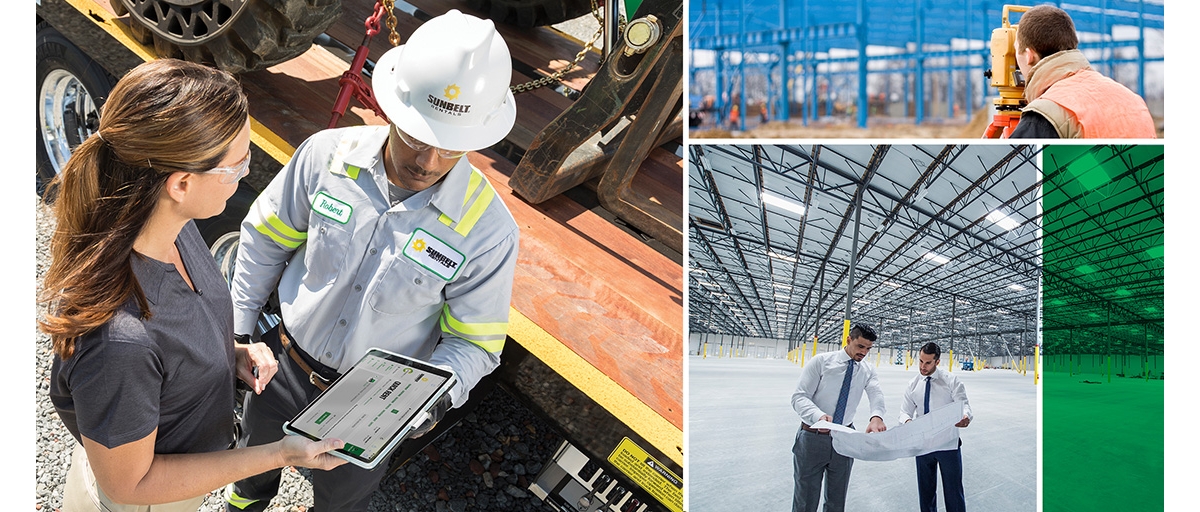
8 Planning Steps to Rightsize Equipment for Warehouse/Distribution Center Construction
Buying dish soap from Walmart or an office chair from West Elm no longer requires hopping in the car to drive to a retail store. With the rise of omnichannel retail, consumers have more choices in how they make purchases. More often than not, they choose to buy online.
That’s one of the reasons eCommerce is expected to reach nearly $4.5 billion in market size by 2025. Commercial real estate experts anticipate the U.S. will need an additional 330 million square feet of distribution space by that time to meet eCommerce demand.
From excavators, scissor lifts, and trenchers to temporary structures, air compressors, and generators, Sunbelt Rentals can assist you in rightsizing your equipment to keep warehouse and distribution center builds on schedule and on budget.
Our planning checklist will help you think through your next warehouse or distribution center project.

1. What’s the Task?
Identify what you’re trying to achieve and then work backward to figure out which piece of equipment can best handle the job. Does the worksite have a utility connection, or will you need generators to power your build? What kind of stormwater infrastructure needs to be added? Will the property need to be graded, or is that already completed? Make a list of every task that’s part of your project and then determine the machinery and accessories you need to tackle each one.
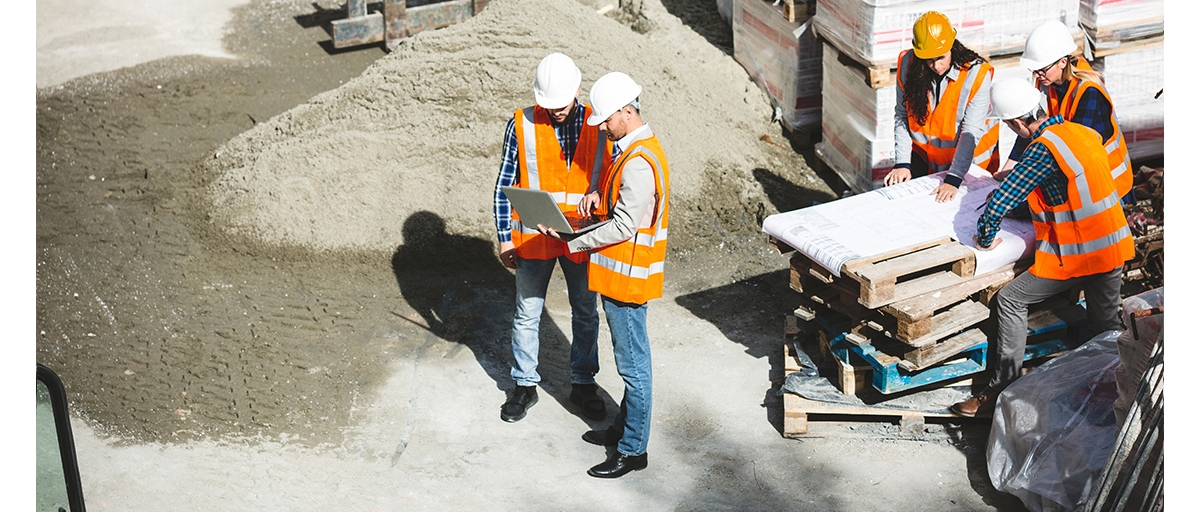
2. How Large Is Your Workforce?
Cross-reference the tasks you need to complete with the projected start date and budget to rough out a schedule. Next, consider the amount of time and manpower available for each job to determine the machines you’ll need and what each must be capable of doing.
For example, smaller pieces of equipment may not be powerful enough for heavy digging or loading or as efficient as larger machines when moving massive volumes of material. But the workforce available also makes a difference in how quickly you can finish a job.
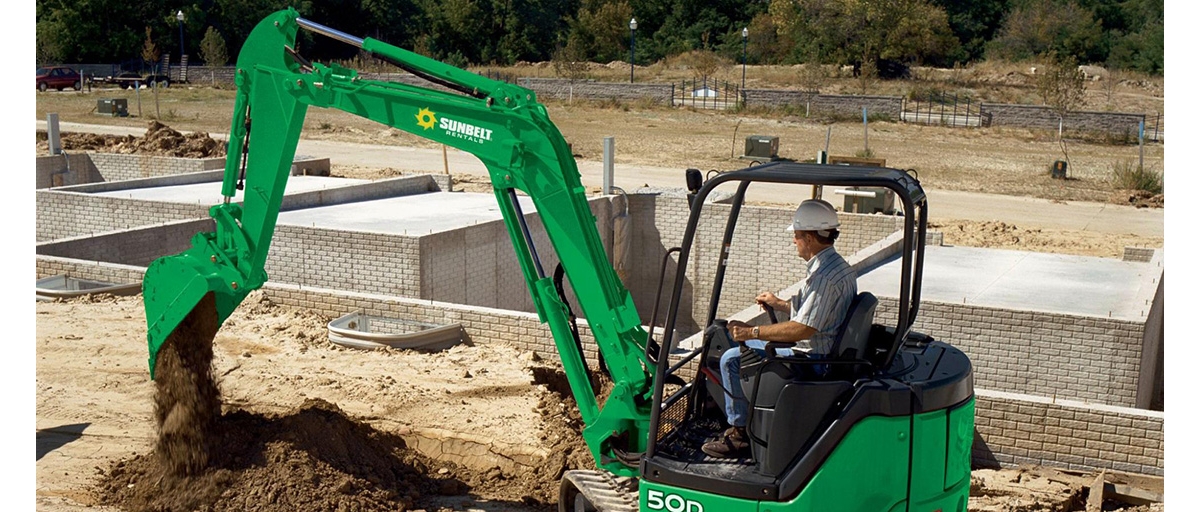
3. What Are the Jobsite Conditions?
To determine proper sizing, you need to evaluate what will be under your equipment everywhere it will be used. For instance, the large bulldozer you’d like to use may roll over rock just fine but will get mired in mud. If you want to use equipment inside the building, you’ll also need to know what weight the structure is rated to handle. During interior lighting and shelving installation in a distribution center, you’ll need scissor lifts and forklifts. If keeping the floor pristine is critical, make sure to use machines with nonmarking tires or bring in floor protection.
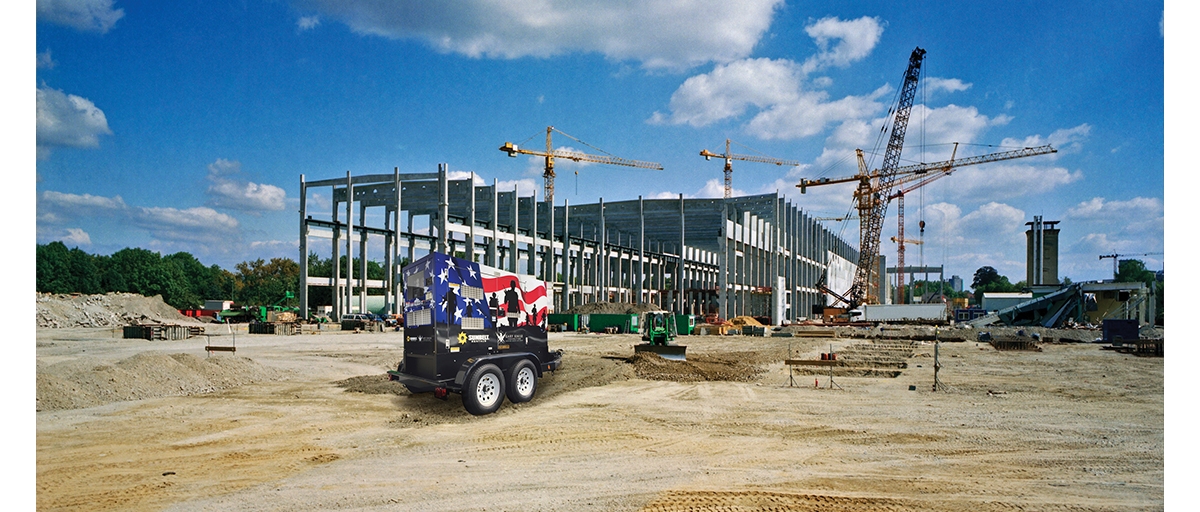
4. What Are the Space Constraints?
You’ll need room to move and maneuver both inside and outside of your structure. Depending on the configuration, you may be limited to using small equipment, even though you prefer large machines. If you need powerful equipment for inside work, make sure the building has an opening sufficient to accommodate even the largest machines. Also, determine where to park equipment to perform every project task and how close to the facility you can get. Sunbelt Rentals can help you set up a secure on-site tool yard that simplifies inventory management with subcontractors.
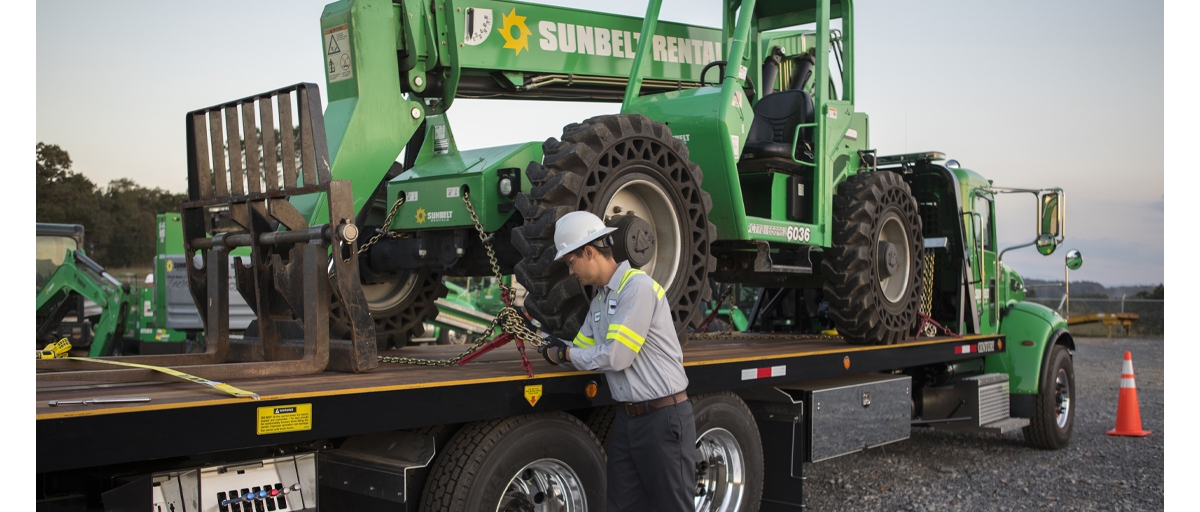
5. How Will You Transport Equipment?
Confirm in advance how the equipment will get on and off the jobsite safely, without getting tangled in overhead power lines or stuck under low bridges. Decide how you plan to tow or transport machinery, and make sure you’re in compliance with local hauling restrictions. If you need a tractor trailer, check the route and weight constraints to see if it can use public roadways to get to your jobsite. For projects in urban areas, check to see if your preferred type of equipment and mode of transportation is possible in narrow alleys and winding streets.
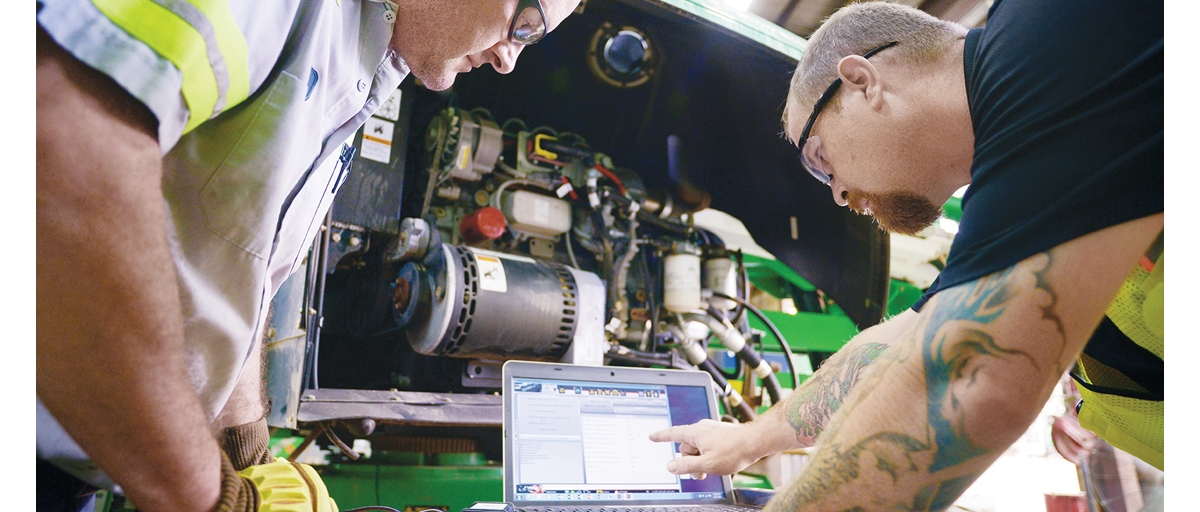
6. What Are Your Equipment Maintenance Needs?
Is it a multimonth or multiyear project? Consider the anticipated weather conditions and whether crews will work extended or standard shifts to better understand the maintenance needs of the equipment.
Sunbelt Rentals offers turnkey maintenance, fueling, and telematic data services to help your worksite run efficiently.

7. What Will It Cost?
You need to consider operating costs for each piece of equipment as well as the price to rent it. You will pay more for large equipment than for small machines. The operating costs for large equipment will be higher as well, especially for fuel. Still, you may be able to complete projects more quickly and pay less overall with more robust machines. So, balance cost with the additional time and people that using smaller equipment may require.
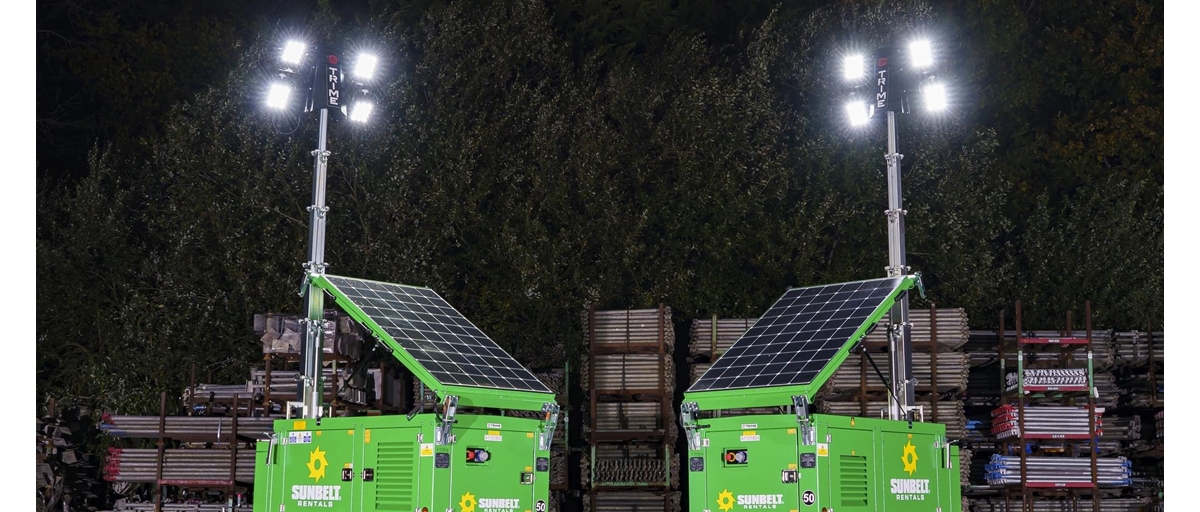
8. Does the Project Have Sustainability Goals?
Is the distribution center being constructed in adherence to a sustainable building program, such as LEED, or Leadership in Energy and Environmental Design, rating system? Has the property owner prioritized sustainability from construction to operation of the distribution center? Many of Sunbelt Rentals’ machines are fuel efficient or electric, with smart power management solutions to conserve fuel.
Sunbelt Rentals’ Green Equipment Includes:
- Battery energy storage system
- Bobcat All-Electric Compact Track Loader
- EV charging stations
- Electric concrete grinder
- Electric manlift
- Electric scissor lift
- Electric telehandler
- Electric tools
- Solar light tower
Sunbelt Rentals offers hundreds of types of high-quality machines to support warehouse and data center construction, so you don’t have to contact multiple companies to rightsize all the equipment needed for your project. Plus, we have the technical expertise to help you choose the perfect machine for every task, and we offer setup support to show your workers how to safely use the equipment.
Contact us to learn more about how Sunbelt Rentals can help.
